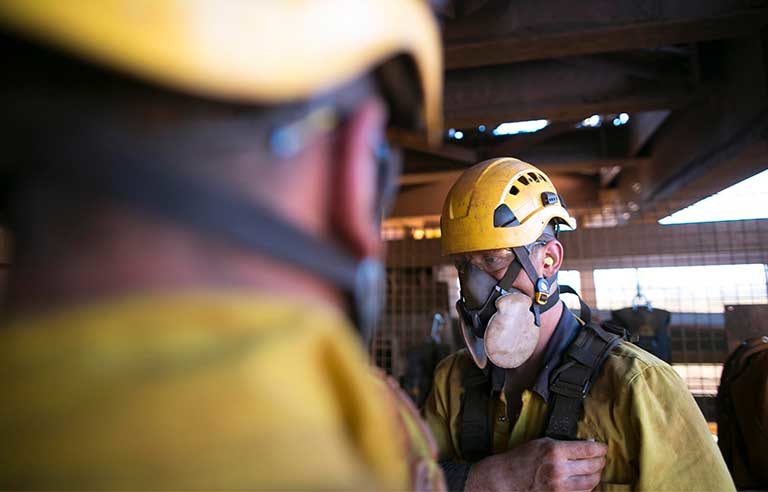Occupational silica exposure
How can I best protect my workers from on-the-job silica exposure?

Responding is Dan Glucksman, senior director of policy, International Safety Equipment Association, Arlington, VA.
Silica has been a hazard for thousands of years. According to a recent report in the Los Angeles Times, workers in California’s engineered stone cutting industry have developed – in a shorter time frame than normally seen for this hazard – crippling silicosis in the past few months. Some patients in California died in their 30s, the Centers for Disease Control and Prevention reports. The root cause is the booming popularity of countertops made of engineered stone, which have, OSHA and NIOSH note, higher concentrations of silica than natural stone. It’s a tragedy because this work can be done safely.
OSHA has recently taken a more active approach to educating workers and employers about the hazards of respirable crystalline silica exposure in the stone countertop and concrete industries, issuing a National Enforcement Program.
The following can be used to recognize, anticipate and control hazards associated with tasks that generate respirable crystalline silica dust in air.
1. Conduct a job hazard analysis
A JHA asks managers and employees to review work tasks and practices and assess the hazards. OSHA provides a JHA how-to document.
The agency has many tools to help keep workers safe from silica, including a hazard alert focused on countertop manufacturing, finishing and installation.
CPWR – The Center for Construction Researcher and Training has resources for safe work in stone cutting. CPWR’s website offers a Create-a-Plan tool to control silica dust.
OSHA’s NEP calls on “each area office in Regions 1-8 to complete a minimum of five programmed inspections … of establishments working with engineered stone, within 12 months from the date of this initiative.”
2. Work safely with silica
OSHA’s On-Site Consultation Program offers employers free health and safety consultations. In California, which has a high rate of silicosis cases from cutting engineered stone, employers can visit the state’s Division of Occupational Safety and Health consultation service.
In additions, Silica-Safe has tools you can use to control this dangerous dust.
3. Select the right PPE
The appropriate personal protective equipment for cutting engineered stone includes:
Respiratory protection. When exposure to silica can’t be controlled to acceptable levels with engineering or administrative methods – such as wetting work surfaces, using dust collection tools or placing workers outside of the dust generation zone – respiratory protection can be used to help reduce exposure. Employers should choose respirator types that have assigned protection factors that are high enough to reduce exposure to acceptable levels. Based on exposure levels measured in the hazard alert, it’s likely that at least a tight-fitting negative-pressure full facepiece or powered air-purifying respirator would be needed. Both options would also provide the wearer with eye and face protection, which is also likely needed. It’s essential that respirators be used correctly during all times of exposure.
Protective garments. Silica is a hazardous particulate that can be suspended in the air during the manufacture and polishing of stone countertops. As such, silica can be considered a “take home toxin,” which can cause injury or illness to family members if taken out of the working environment and into the home on an employee’s clothing. Employers must provide a reusable or disposable protective coverall to ensure hazards remain in the work area. Employers must also provide appropriate PPE selection, donning and doffing procedures and policies.
Gloves. When moving and handling stone and operating masonry saws, hand protection is critical. Traumatic upper-thumb injuries are common among workers using power saws.
Eyewear. For workers who don’t wear respirators with integrated eye protection, safety glasses or goggles are needed to help protect against eye injury from projectiles and dust generated by cutting and grinding operations.
Hearing protection. Cutting and grinding operations tend to generate noise greater than 100 dBA, according to NIOSH. Over the course of a shift, exposure to these noise levels can damage workers’ hearing, so hearing protection should be worn when performing or working near cutting and grinding operations.
Need help selecting the right PPE? Qualified safety sales professionals, certified industrial hygienists and certified safety pros are all highly trained and qualified to evaluate work practices and tasks, assess hazards, and make recommendations for maximizing safety.
Workers deserve to go home at the end of the workday with their health and safety intact. Proper health and safety practices can help address the hazards associated with manufactured stone cutting.
Editor's note: This article represents the independent views of the author and should not be considered a National Safety Council endorsement.
Post a comment to this article
Safety+Health welcomes comments that promote respectful dialogue. Please stay on topic. Comments that contain personal attacks, profanity or abusive language – or those aggressively promoting products or services – will be removed. We reserve the right to determine which comments violate our comment policy. (Anonymous comments are welcome; merely skip the “name” field in the comment box. An email address is required but will not be included with your comment.)

